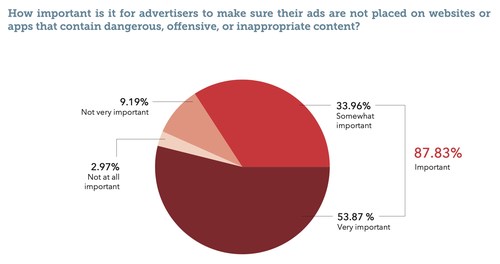Three-Quarters of Respondents Say Controversial News Topics Are Safe for Ads; Large Majority Back Ad-Supported Coverage of Ukraine War
WASHINGTON, Oct. 27, 2022 /PRNewswire/ — Despite graphic violence in news coverage of the war in Ukraine and other controversial topics in the news, U.S. consumers broadly believe that all news content is appropriate for ads, according to the 2022 TAG/BSI US Consumer Brand Safety Survey, conducted by the Trustworthy Accountability Group (TAG) and Brand Safety Institute (BSI).
Only one in four respondents said any specific news topic should be off-limits to ads, while nearly half (46 percent) said all high-quality journalism should be appropriate for ads. Reinforcing those findings by more than a two-to-one margin (69 percent to 31 percent), respondents said the importance of ad funding for coverage of the Ukraine war outweighed any risk of violent content in that coverage.
“It looks like the answer to ‘What is brand-safe journalism?’ may be ‘All of it,'” said Mike Zaneis, CEO of TAG. “Consumers clearly see the value to high-quality, ad-supported journalism, and they prioritize funding for those news-gathering operations over any risk of ad misplacement with sensitive or controversial news-related content. This is good news for both advertisers and publishers, who can protect ad-funded journalism and the large audiences who follow it, while turning their attention to more complex brand suitability issues around the types of content that are most appropriate for their brands.”
When asked about specific topics, only small minorities of respondents said news coverage of those subjects should not be supported by ads, such as news about the war in Ukraine (19 percent), COVID-19 (19 percent), riots/civil unrest (22 percent), police brutality (22 percent), drug abuse/overdoses (23 percent), LGBTQ+ issues (23 percent), abortion (23 percent), school shootings (25 percent), controversial politicians (26 percent), or murder/violent crime (27 percent).
By contrast, far larger percentages of respondents said nine other types of non-news content should be blocked by advertisers. Those “noxious nine” topics, which align with equivalent categories in the GARM Brand Safety Suitability Framework, are:
- Sexually-explicit or pornographic content (70 percent said block nearby ads)
- Hate speech or racist content (70 percent)
- Unsafe or hacked websites (68 percent)
- Illegal drug-related content (65 percent)
- Terrorism-related content (59 percent)
- Content about violence, injury, or death (53 percent)
- Stolen/pirated movies or TV shows (48 percent)
- Profanity or obscene language (48 percent)
- Gun and ammunition-related content (46 percent)
“Brand safety issues are complicated and often involve a spectrum of shades of gray, which is why education of key stakeholders across the industry is so important,” said Neal Thurman, co-founder of BSI. “This survey highlights the nuanced perspective that consumers are developing around brand safety and suitability topics, and the findings can help inform the decisions that brands, publishers, and other stakeholders are making, as they work to protect their brands, ad campaigns, and customers from unsafe and inappropriate content.”
Among other findings of the survey:
- Consumers believe that brand unsafe content is pervasive online, with respondents saying they believe roughly half (51 percent) of all online content is dangerous, offensive, or inappropriate
- More than three-quarters (76 percent) said the U.S. had the biggest problem with dangerous, offensive, or inappropriate content online versus just 11 percent for the U.K./Europe and 13 percent for the Asia-Pacific region
- A large majority of respondents (85 percent) said hate speech has increased online over the last year, including 45 percent saying it increased “a great deal”
- An overwhelming majority (88 percent) said it is very or somewhat important that advertisers ensure their ads are not placed near brand unsafe content
- A similarly large group of respondents (88 percent) said they would feel more positive about a company that required its partners to be independently certified for brand safety
- Respondents felt the responsibility for brand safety should be shared across participants in the ad ecosystem, including advertisers (60 percent), ad agencies (58 percent), tech providers (48 percent), and publishers (59 percent)
This is the fourth consumer survey conducted by TAG and BSI on brand safety topics, following a survey conducted of U.K. consumers in 2022 and the last survey conducted of US consumers in 2020. The full results of the 2022 TAG/BSI Consumer Brand Safety Survey can be found here.
The survey of 1,110 adults in the United States was conducted via SurveyMonkey Oct. 10-11, 2022. The survey had a margin of error of +/-3 percent at a 95 percent confidence interval.
The Trustworthy Accountability Group (TAG) is the leading global certification program fighting criminal activity and strengthening brand safety in the digital advertising industry. TAG advances its mission of eliminating fraudulent traffic, facilitating the sharing of threat intelligence, and promoting brand safety by connecting industry leaders, analyzing threats, and sharing best practices worldwide. The 600+ member TAG community includes the world’s largest and most influential brands, agencies, publishers, and ad tech providers. TAG is the first and only Information Sharing and Analysis Organization (ISAO) for the digital advertising industry. For more information on TAG, please visit tagtoday.net.
The Brand Safety Institute is a digital advertising industry initiative to professionalize the work of brand protection. Through its research, education, and certification programs, the Brand Safety Institute gives ad industry executives the expertise and skills they need to minimize brand risks and capitalize on brand opportunities in the digital advertising supply chain. Through its Brand Safety Officer certification program, the Brand Safety Institute helps leaders set the highest standards for brand protection, learn new and emerging best practices, and build an industry-wide community of brand safety peers. More information about the Brand Safety Institute can be found at brandsafetyinstitute.com.
Media Contact:
Andrew Weinstein
202-667-4967
347606@email4pr.com
SOURCE Trustworthy Accountability Group


